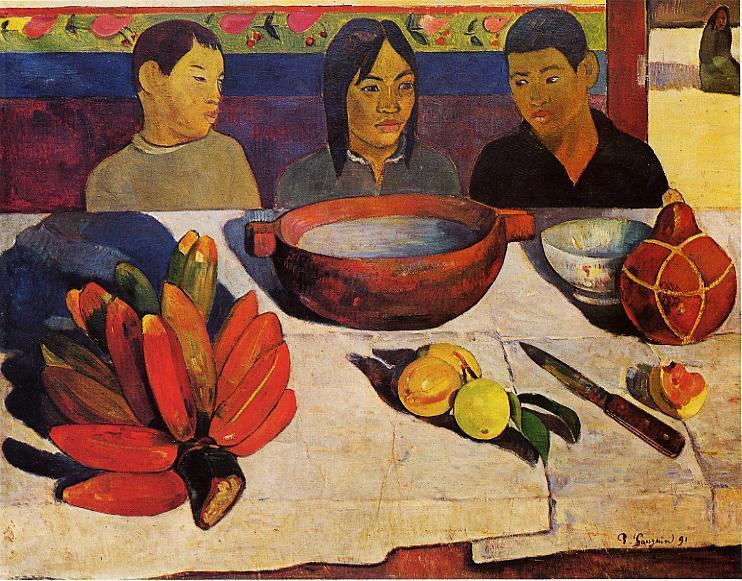Descriere
Paul Gauguin's "The Meal (The Bananas)", created in 1891, is a thought-provoking piece about the complexity of its visual elements and its historical context. This oil on canvas is part of the period when Gauguin, in his search for new forms of expression, moved to Tahiti, where he immersed himself in the life and culture of the island. This painting is not only a representation of an everyday scene, but is also an exploration of the relationship between humans and their food environment.
In the foreground of the painting, bananas stand out, acting as the central element. Their arrangement and vibrant yellow hues are a reflection of the abundance and sensuality of tropical nature. Gauguin uses an almost sculptural treatment of the fruits, giving them an organic character that comes to life thanks to the fluidity of the brush. The way in which the bananas are grouped and intertwined evokes a sense of movement and dynamism, while their intense color creates a notable contrast with the more subtle background, where brown and terracotta tones predominate, evoking the earth and the warmth of the climate.
The depiction of human figures is subtle and located in the background of the composition. Two women, possibly from Tahitian culture, share a meal while immersing themselves in a moment of interaction. Although Gauguin does not seek an explicit narrative approach, his arrangement suggests a connection between them, an intimacy that is accentuated by the soft light that illuminates their faces. This focus on the figures, together with the use of warm colors and a palette that is harmonious and vibrant, highlights the artist's interest in capturing the daily life of the people who inhabited the island, in an attempt to rescue its genuine beauty and simplicity.
The use of color is one of the most outstanding aspects of the work. Gauguin plays with a palette that feels both vibrant and unified, where warm tones predominate to project an atmosphere of joy and plenitude. The technique of applying layers of color, characteristic of post-impressionism, creates a textured effect that gives depth to the work. In "The Food (The Bananas)", the artist distances himself from classical naturalistic representation and delves into a more symbolic approach, where color and form become means to express more abstract emotions and concepts.
This painting is representative of Gauguin's distinctive style, often characterized by its formal simplicity and its exploration of exotic and spiritual themes. His fascination with the primitive and the wild is articulated through his choice of Tahitian subjects, creating a contrast between European traditions and the indigenous cultural values that he strove to understand and transmit. In this sense, "The Meal (The Bananas)" can be seen as a testament to his own artistic and spiritual journey, a search for a deeper connection with a world that he perceived as authentic and pure.
In conclusion, The Meal (The Bananas) is not simply a depiction of a scene from everyday life, but a microcosm of Gauguin's interest in humanity, nature and colour. It is a work that, through its simplicity, invites viewers to contemplate the depth of life and human relationships. In this sense, it stands as one of the many cornerstones of the transition between Impressionism and Symbolism, leaving an indelible mark on the history of modern art.
KUADROS ©, a famous painting on your wall.
Hand-made oil painting reproductions, with the quality of professional artists and the distinctive seal of KUADROS ©.
Painting reproduction service with satisfaction guarantee. If you are not completely satisfied with the replica of your painting, we will refund 100% of your money.

